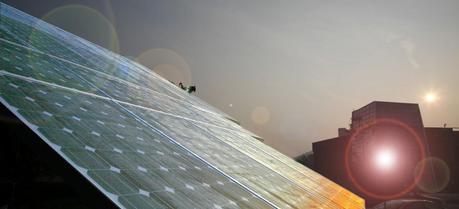 ORNL Aims to Develop Cheap Copper Oxide Solar Cell. (Credit: Oak Ridge National Laboratory)
ORNL Aims to Develop Cheap Copper Oxide Solar Cell. (Credit: Oak Ridge National Laboratory)Amit Goyal and his team of research scientists are using copper oxide to redesign the face of solar power. The once-dismissed solar semiconductor, one of the first discovered, is the basis of ongoing research at Oak Ridge National Laboratory (ORNL).
“If we could make efficient solar cells out of copper oxide, it would be a major game changer,” Goyal said. “It’s cheap, earth-abundant and nontoxic in contrast to the photovoltaic materials being used today.”
The question, however, is solar cell efficiency.
The researchers have completed the first component of their project by developing a working p-type layer—a layer of semiconductor material made from copper oxide that is not only single-crystal like, but also has excellent electronic properties. Now their focus is on the second half of the project: developing a working n-type layer that will sit atop the p-type layer and form the required p-n junction.
“We must develop the p-n junction,” Goyal said. “But before we can do that, we need to make the n-type layer. Once we get a good n-type layer, we should be able to combine it with our nice copper oxide layer to make a highly efficient solar cell.”
The p-n junction is the interface between the two layers of semiconductor material and is the building block of the solar cell. Getting the p-n junction just right is essential for the copper oxide solar cell to work properly.
Using copper as a base for these new solar cells could have major influence on the future of power sources, which lacks safe, earth-abundant materials.
“That’s the whole interest in the work,” Goyal said. “All the motivation driving us is that the world doesn’t have a low-cost, nontoxic, earth-abundant, efficient solar cell.”
Copper is abundant from a resource perspective and it’s not anticipated to be a limited resource, although the price could fluctuate depending on where it is being produced. Just because it is abundant doesn’t mean the rest of the work will be easy, according to Goyal, who noted that a lot of work is needed to produce the n-type layer.
“We have a template that we can use and we have a way to make the copper oxide layer work well, but you cannot underscore the need to come up with the n-type layer and make the junction properties work,” Goyal said. “That work is significant and I don’t want to undermine the work that is left to do.”
Creating the n-type layer is the next hardest part of the project. Calculations and experiments are vital in determining what works and what doesn’t. The n-type layer has to provide good junction without reacting with the p-type layer when they’re joined.
The marker is very simple—every solar cell is going to need to reach grid parity, meaning solar energy has to cost the same as fossil fuel energy. Much more powerful solar cells can be made, but at a much higher cost.
“We need to work on the layers and get them to work. If we can do that, then it’ll be fascinating,” Goyal said

